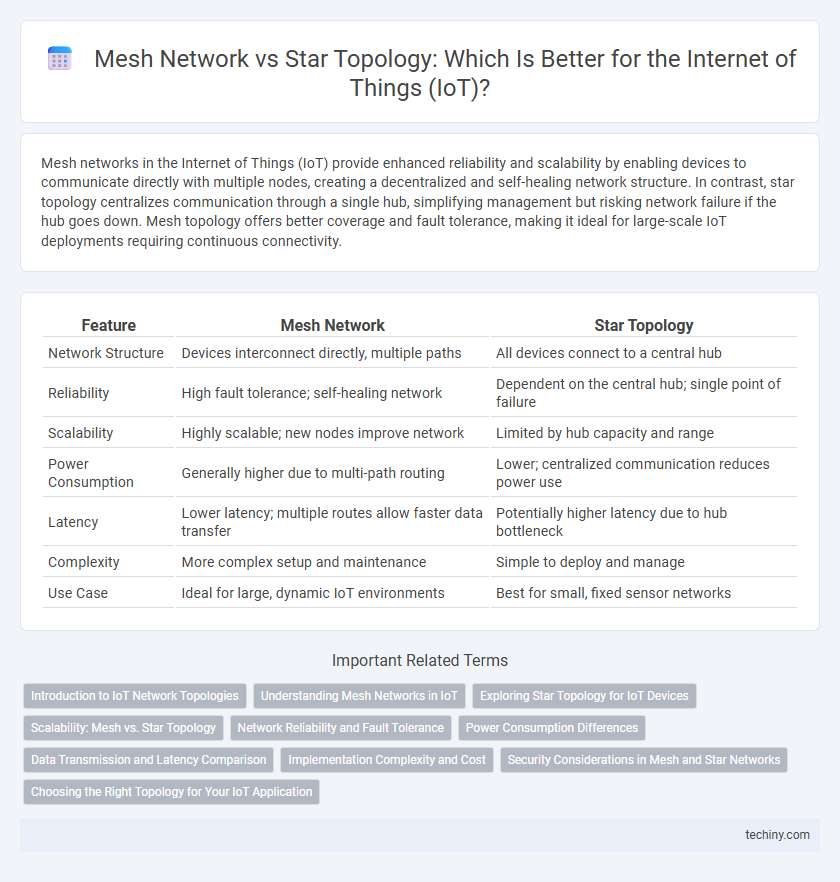Mesh networks in the Internet of Things (IoT) provide enhanced reliability and scalability by enabling devices to communicate directly with multiple nodes, creating a decentralized and self-healing network structure. In contrast, star topology centralizes communication through a single hub, simplifying management but risking network failure if the hub goes down. Mesh topology offers better coverage and fault tolerance, making it ideal for large-scale IoT deployments requiring continuous connectivity.
Table of Comparison
| Feature | Mesh Network | Star Topology |
|---|---|---|
| Network Structure | Devices interconnect directly, multiple paths | All devices connect to a central hub |
| Reliability | High fault tolerance; self-healing network | Dependent on the central hub; single point of failure |
| Scalability | Highly scalable; new nodes improve network | Limited by hub capacity and range |
| Power Consumption | Generally higher due to multi-path routing | Lower; centralized communication reduces power use |
| Latency | Lower latency; multiple routes allow faster data transfer | Potentially higher latency due to hub bottleneck |
| Complexity | More complex setup and maintenance | Simple to deploy and manage |
| Use Case | Ideal for large, dynamic IoT environments | Best for small, fixed sensor networks |
Introduction to IoT Network Topologies
Mesh network topology in IoT provides robust, self-healing communication where each device connects directly or indirectly to multiple others, enhancing reliability and coverage in large-scale deployments. Star topology features a central hub managing all device communications, simplifying network management but creating a potential single point of failure. Choosing between mesh and star topologies depends on factors like network size, device density, and reliability requirements in IoT applications.
Understanding Mesh Networks in IoT
Mesh networks in IoT enable devices to connect directly, dynamically, and non-hierarchically, ensuring robust communication even if one node fails. Each device acts as a relay point, expanding coverage and enhancing network reliability compared to star topology, which relies on a central hub vulnerable to single points of failure. This decentralized structure of mesh networks supports scalable, self-healing systems essential for complex IoT environments.
Exploring Star Topology for IoT Devices
Star topology in IoT devices centralizes communication through a single hub, allowing efficient management and straightforward troubleshooting for connected sensors and actuators. This topology enhances network reliability by isolating device failures, preventing them from disrupting the entire system, which is critical for smart home and industrial automation applications. Its scalability and low latency communication make star topology ideal for real-time data transmission in IoT deployments requiring consistent performance and minimal interference.
Scalability: Mesh vs. Star Topology
Mesh topology offers superior scalability for Internet of Things (IoT) deployments by enabling devices to connect dynamically and extend network coverage through multiple interconnections. In contrast, star topology relies on a central hub, limiting scalability as the number of connected devices increases and potentially creating a bottleneck. Mesh networks support larger, more flexible IoT ecosystems by distributing data traffic efficiently across nodes, enhancing overall network resilience and expansion capabilities.
Network Reliability and Fault Tolerance
Mesh networks in IoT offer superior network reliability and fault tolerance by enabling multiple redundant communication paths, ensuring continuous data flow even if one node fails. Star topology relies heavily on a central hub, making it vulnerable to single points of failure that disrupt the entire network. The decentralized structure of mesh networks enhances robustness, critical for maintaining seamless connectivity in large-scale IoT deployments.
Power Consumption Differences
Mesh networks in Internet of Things (IoT) typically consume more power due to multiple devices acting as repeaters to maintain network connectivity, increasing overall energy use. Star topology generally exhibits lower power consumption since end devices communicate directly with a central hub, reducing the need for continuous device-to-device transmissions. Power efficiency in IoT deployments often favors star topology for battery-powered devices, while mesh networks offer improved coverage at the expense of higher energy demands.
Data Transmission and Latency Comparison
Mesh networks in the Internet of Things (IoT) provide multi-path data transmission, significantly reducing latency by enabling devices to transmit data through multiple nodes simultaneously. Star topology relies on direct communication between each device and a central hub, often increasing latency due to potential hub congestion and single-point data routing. Mesh architecture enhances reliability and speed by distributing data across several paths, while star topology may introduce delays during high traffic periods due to its centralized data handling.
Implementation Complexity and Cost
Mesh networks in Internet of Things (IoT) systems exhibit higher implementation complexity due to the necessity of configuring multiple inter-device communication paths and dynamic routing protocols, which increases development time and expertise requirements. Star topology offers simpler implementation with straightforward device-to-central hub connections, resulting in lower initial setup costs and easier maintenance. However, mesh networks incur higher overall expenses from sophisticated hardware and software demands but provide greater scalability and network resilience.
Security Considerations in Mesh and Star Networks
Mesh networks enhance security by enabling multiple data paths, reducing single points of failure and making it harder for attackers to isolate or disrupt communication. Star networks centralize data flow through a hub, creating a critical vulnerability; if the hub is compromised, the entire network can be exposed to attacks. Encryption protocols and authentication mechanisms must be rigorously applied in both topologies to safeguard data integrity and prevent unauthorized access in Internet of Things environments.
Choosing the Right Topology for Your IoT Application
Selecting the optimal topology for your IoT application hinges on factors such as network size, reliability requirements, and power consumption. Mesh networks offer enhanced scalability and fault tolerance by allowing devices to communicate directly, ideal for large-scale, complex deployments. Conversely, star topology suits simpler setups with centralized control, providing straightforward maintenance and lower latency but limited range and dependency on a central hub.
mesh network vs star topology Infographic

 techiny.com
techiny.com